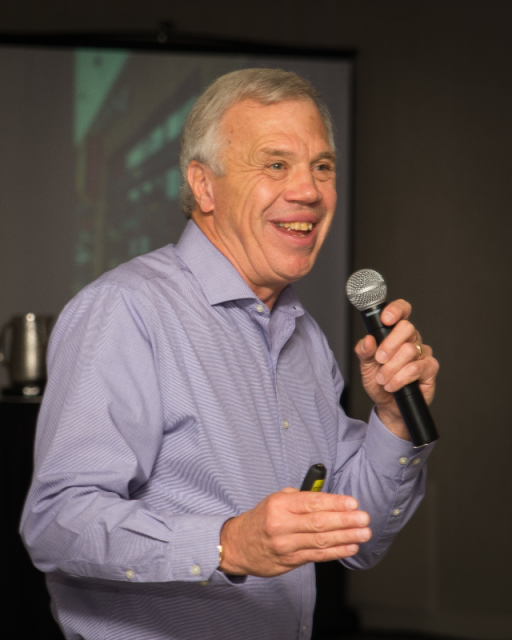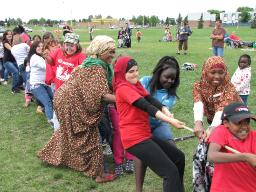
Jim Diers is driven by a passion to get people more involved in their communities and in the decisions that affect their lives. Over the past 40 years, he has served as a grass roots community organizer, community developer, and founding director of Seattle’s Department of Neighborhoods. Jim now shares the lessons from that work in his courses at the University of Washington; in international consulting through the Asset-Based Community Development Institute; and in his book, Neighbor Power. He has been recognized with an honorary doctorate from Grinnell College and as the Public Employee of the Year by the Municipal League of Martin Luther King County.
State or Province:
country:
USwhat are your gifts and talents?:
why do you want to join abcd in action?:
You Can't Build Community Without Doing The Bump

Community is built on relationships and people develop relationships through frequent contact with others. So, if you want to build community, you need places to bump into other people. The closer those places are to where you live, the more likely you are to bump into the same people over and over again.
Most neighborhoods have an abundance of bumping places. There are public places such as community centers, libraries, schools, parks, athletic facilities, sidewalks and trails. Local business districts with their pubs, coffee shops, grocery stores and other bumping places can be equally effective. There are also collectively owned gathering spaces such as clubhouses and places of worship.
Unfortunately, neighborhoods have been losing their traditional bumping places. Benches have been removed and access to parks and other public spaces has been restricted out of a concern that the “wrong people” have been using them. Online shopping, big box retail and gigantic malls have led to a decline in many neighborhood business districts. Regional so-called community centers are replacing those that were neighborhood-based. The large scale of many new recreation and retail facilities leaves people lost in the crowd and anonymous. An increasingly mobile population often shops, works, recreates, worships, and attends school outside of the neighborhood where they live. People have many different communities, and in a sense, they have no community at all. They seldom bump into the same people in more than one place.
Some neighborhoods were never designed for bumping into other people. Bedroom communities are often more friendly to cars than pedestrians. There are no places to shop, eat or drink within walking distance even if there are the rare sidewalks. Residents drive in and out of a garage adjoining their house and have little opportunity to bump into neighbors. Likewise, there is a dearth of bumping places in rural areas, and long distances between houses make it difficult to connect.
People are social creatures, however, so there has been a growing interest in placemaking. Rather than trying to prevent people from using public spaces, the new thinking is that safety is better achieved by attracting more people from all walks of life. Business districts are being revitalized by creating a distinctive experience that malls can’t replicate – small scale gathering places, shops and restaurants with a local flavor, personalized service, and community-based events such as art walks, heritage days and parades. The local food movement is bringing us community gardens, community kitchens, farmers markets and other prime bumping places. At the block level, neighbors are reclaiming their streets by painting murals in the intersections, installing street furniture, and periodically closing the street for parties and play. Apartment buildings and condos sometimes have rooms for common use, but when they don’t, a sofa or a table with a teapot might be placed in the lobby or next to the elevator to spark interaction. Some people are turning their homes into bumping places by installing a little free library, moving their barbeque to the front lawn, staging concerts on their front porch, or hosting welcome dinners for new neighbors.
Creating bumping places in suburban and rural areas can be more challenging, but they also have homes and yards that could be used for gatherings of neighbors. Practically everywhere has a closed or underutilized school, church, grange hall, or other facility that could serve as a venue for community dinners, educational programs, concerts, dances, movies, swap meets, cider making, game nights, holiday parties and all sorts of other events that would attract the neighbors. Portable bumping spaces are another option; some communities operate a wood-fired pizza oven, tea station or espresso cart that can be driven or pedaled to a prominent intersection, popular trail, cul de sac, or other location where people are likely to congregate around it.
Sometimes, though, the only option is to start with virtual bumping. In new suburbs where the housing is being developed more quickly than the public infrastructure, communities have effectively used a Facebook page as their initial bumping place. Contact on the internet can lead to relationships in real life. I’ve heard many stories of Facebook friends helping one another in times of need even though they had not previously met one another physically.
If you want to develop an inclusive community, you need to have inclusive bumping spaces. While neighbors typically have all kinds of differences in terms of age, income, culture, religion, politics, interests, etc. they tend to gather with people who are like themselves. To be inclusive, a place should be accessible to those with differing abilities and incomes. To the extent that the place includes signage and art, it should reflect the full range of languages and cultures in the neighborhood.
A key reason why places aren’t sufficiently inclusive is because so many are single purpose. They only attract gardeners, basketball players, seniors or whomever the space was specifically designed for. An inclusive place will be multi-purpose. Project for Public Spaces, the premier placemaking organization, calls this the Power of 10. They assert that every place should accommodate at least ten different kinds of activities. Not only will this make the place more inviting to a wide range of users, but it will make it more likely that the place will be used more extensively, at all times of the day and during all seasons of the year making it safer for everyone.
Having an inclusive space isn’t sufficient, however. We’ve all experienced elevators, bus stops and other public places that are crowded with people doing their best not to make eye contact with anyone else. Sometimes an intervention is needed to get people off of their smartphones and interacting with one another.
Public libraries are a good example. They attract neighbors from all walks of life, but the diverse readers seldom interact except for families during Saturday morning story hours. Increasingly, though, libraries are trying to serve as the neighborhood’s living room. Many libraries have incorporated coffee shops or other spaces where people aren’t shushed. Some have living book programs through which a person can spend time getting to know someone who is different than themself. After hours, libraries have hosted sleepovers, concerts and even miniature golf where people putt their way through the stacks of the Dewey decimal system.
My favorite bumping places are the ones that are designed and built by the neighbors. These places are most likely to reflect what is special about the residents and their neighborhood, and they are designed to work for the people who live there. Through creating the place, neighbors feel a sense of ownership. They are more likely to use, maintain and program it.
Of course, it is critical that the design/build process is inclusive as well. All of the potential users, whether they are young or old, business or homeless people, have a valuable perspective to bring to the design process and everyone has contributions they can make to creating a place that makes it possible to do the bump together.
